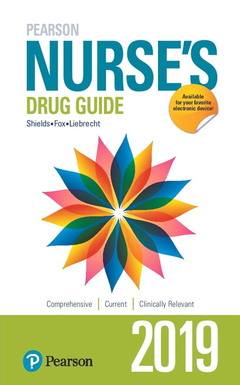Description
Pearson Nurse's Drug Guide 2019
Authors: Wilson Billie, Shannon Margaret, Shields Kelly
Language: English
Subject for Pearson Nurse's Drug Guide 2019:
Approximative price 52.74 €
In Print (Delivery period: 12 days).
Add to cart1936 p. · 12.6x19.9 cm · Paperback
Description
/li>Contents
/li>Biography
/li>Comment
/li>
For nursing courses covering drugs or drug administration.
A quick-reference guide to safe, effective drug administration, in any setting
Pearson Nurse?s Drug Guide 2019 is a current and reliable reference for comprehensive information needed to make appropriate decisions for drug administration. Designed for quick, easy lookup, it lists drugs alphabetically by generic name and it indexes drugs by both generic and trade names. The guide also provides clinical information for hundreds of drugs, including adverse reactions, interactions, side effects, and impact on lab results. The 2019 edition features 18 new monographs for drugs recently approved by the FDA.
Classification Scheme and Prototype Drugs
Alphabetical Entries for Generic Drugs
Appendices
A. Ocular Medications, Low Molecular Weight Heparins, Inhaled Corticosteroids, Topical Corticosteroids, and Topical Antifungal Agents
B. U.S. Schedules of Controlled Substances
C. FDA Pregnancy Information
D. Oral Dosage Forms That Should Not Be Crushed
E. Prescription Combination Drugs
F. Glossary of Key Terms, Clinical Conditions, and Associated Signs and Symptoms
G. Abbreviations
H. Herbal and Dietary Supplement Table
I. Look-Alike, Sound-Alike Medications
J. Vaccines
Common Drug IV-Site Compatibility Chart
Kelly M. Shields is currently Associate Dean and Associate Professor of Pharmacy Practice at Ohio Northern University’s Raabe College of Pharmacy. She holds a Doctor of Pharmacy from Butler University and completed a fellowship in Natural Product Information and Research at University of Missouri-Kansas City. She has practiced pharmacy in retail, community, and academic settings and has worked as a freelance medical writer.
Kami L. Fox is the Director/Chair and Associate Professor of the Department of Nursing at Ohio Northern University. She holds a BS and MS in Nursing from Wright State University in Dayton, Ohio, and a DNP from the University of Toledo. She is a certified pediatric nurse practitioner in primary care.
Christina M. Liebrecht is Assistant Professor of Nursing at Ohio Northern University. She holds a BS in Nursing from the University of Toledo, an MS in Nursing from Walden University, and a Doctorate in Nursing Practice from the University of Toledo. She has been in nursing education for the last 18 years with a focus on medical surgical nursing, fundamentals of nursing, and community health nursing as well as the use of simulation to support student learning and safe practice. She continues to practice as a medical surgical nurse in the acute care setting.
Actionable clinical information for specific drugs
- Drug monographs help nurses adjust diagnoses and interventions based on an achieved therapeutic effect, therapeutic failure, manifestation of an adverse effect, or demonstration of a learning need. Pharmacologic classifications are paired with therapeutic classifications for every drug monograph.
- New - The new edition features 18 new monographs for the following drugs recently approved by the FDA:
- abaloparatide
- abemaciclib
- betrixaban
- brodalumab
- delafloxacin
- dupilumab
- enasidenib
- etelcalcetide
- guselkumab
- letermovir
- midostaurin
- naldemedine
- neratinib maleate
- plecanatide
- safinamide
- sarilumab
- secnidazole
- valbenazine
- Glossary of Key Terms, Clinical Conditions, and Associated Signs and Symptoms (Appendix F) provides valuable information on common assessment findings related to the therapeutic effectiveness of specific drugs.
Preparation for safe drug administration
- Detailed administration information is provided for IV preparation and for push, continuous, or intermittent administration.
- Dosage information for patients across the lifespan — neonates, infants, adolescents, adults, and patients with obesity and renal or hepatic impairment — prepares nurses to safely administer drugs to nearly any patient.
- Students receive guidance in providing drug information to patients in hospitals, clinics, and all community settings, along with related nursing implications.
- Clearly demarcated Black Box Warnings alert readers to safety concerns such as serious side effects or life-threatening risks.
Focus on drug classes and familie

